Please view these information tabs to help get Mechanical Clock Hands.
Removing Mechanical Clock Hands
Removing Mechanical Clock Hands is fast and easy to do. The following are hand removal instructions for German mechanical movements post WW2.
German Post WW2 wall, mantle and floor models
Removing mechanical clock hands for post WW2, mantle and floor clocks is quite simple. Turn the hand nut to the left while holding the minute hand with your fingers.
Use some small needle nose pliers to loosen the nut first. Once the nut is loose, turn it with your fingers until it comes off.
Then the minute hand will be able to wiggle straight off its square arbor and off of the clock. The hour hand is a friction fit, so just twist the hour hand back and forth and pull toward you until it comes off.
If having a second hand bit, that is only a friction also, so just grab it with your fingernails, twist and pull off.
American Antique time and strike
These type of movements come in two styles. If there is a minute hand nut, the first style is the same as above.
Be very careful not to lose this hand nut. They are very hard to find and replace. The second style of mechanical clock hands will have a pin holding the minute hand on instead of a nut.
This pin tapers, meaning it's fat on one side and skinny on the other. Just grab the fat side with needle nose pliers and yank the pin out. The minute hand will fall out with a washer.
Save the washer and the tapered pin for ease of reinstalling the hands. If these items happen to get lost, Clockworks offers washers and taper pins for purchase, as well as replacement mechanical clock hands.
German Mechanical-Clock Hand Installation
The installation of a German Mechanical-Clock Hand on a German mechanical movement is quite simple. It is simply the opposite of the removal process.
The minute hand must go through some adjustments if you are replacing the movement. Also if the hands are new. This is so it will point to the correct time when it chimes.
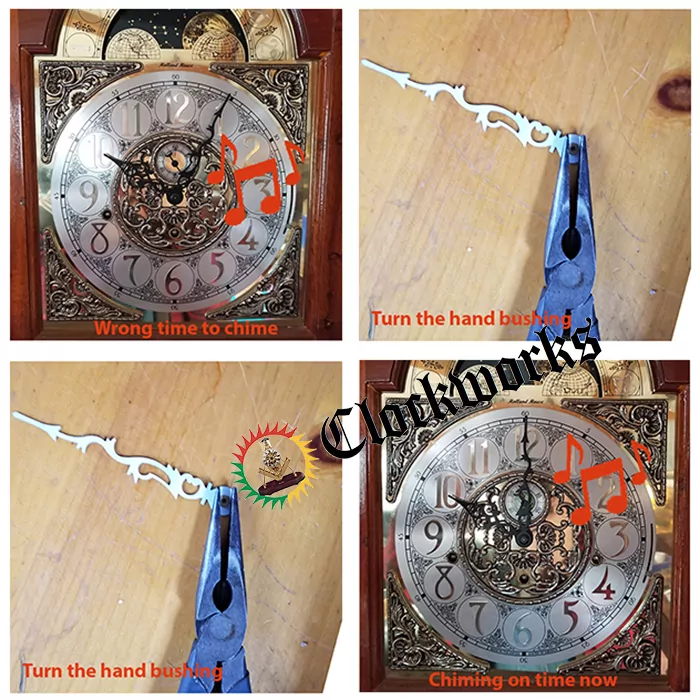
Installing the hour hand
First comes the hour hand. The hour hand is simply a friction fit. All you have to do is put the hand on its round post. Then twist and push toward the front of the dial.
Make sure that it is not in contact with the dial at any point during the rotation.
This includes the base of the hour hand. It cannot rub against the hole that is in the clock face. So, the clock can stop at any point if the hour hand touches anything. You can turn the hand to point to whatever hour it is because it is only a friction fit.
Installing the minute hand
Second, comes the minute hand. Install the minute hand by lining up the the square hole in the hand with the square post of the hand shaft. The bottom of the minute hand cannot be rubbing the hour hand tube or the hour hand. Push the hour hand down further onto the tube if the minute hand is rubbing.
Therefore, it is imperative to check the positioning of the hands to ensure they are not touching anything. Once the minute hand is on its square post, it's time to put the hand nut on.
Tighten the nut with your fingers and then use a pair of needle nose pliers to make it secure. It does not have to be extremely tight. However you need to ensure it is tight enough so that the hands do not come loose as they go around the clock.
Mechanical Clock Hands
German mechanical clock hands are sold by the time track diameter. This measurement is important when ordering these mechanical clock hands. To clarify, the dial diameter is the measurement of the time track.
This means from just outside the 9 straight across to just outside the 3. For example, if the time track diameter is 6 inches, then select hands for a 6 inch time track in the drop down list. Hands for a 6 inch time track will have a minute hand of about 2 7/8 long from the mounting hole to the end.
The hour hand, which is proportionally smaller, will come with the minute hand. This measurement is vastly different than the way you measure quartz clock hands. So be sure to follow these directions for measuring and not the ones for the quartz hands.
Ordering Hands
Choose a style of mechanical hands after getting the time track diameter. There is a drop down menu under each style of hand. Look to see if the style comes in the size you need for the clock.
Not all styles of hands come in the same sizes. So you have to look at the different options available. Serpentine and spade are the most popular mechanical clock hand styles.
Remember, the minute hand will be a little less than half of the time track measurement. The hour hand will be proportional in size to the minute hand.
How they are sent
So, when ordering mechanical clock hands, remember that they come as a pair, hour and minute hand. They ship the next business day from Clockworks in Huntington MA USA, via the method that is chosen upon checkout.
Mechanical Clock Chime On Time
These are the directions to get a German mechanical clock to chime on time. This means having the clock hands point to the right spot when the clock chimes.
When replacing a clock movement, or getting new clock hands, either one, you will notice it will chime 5 minutes before it should, or 10 min after, something like this. This page explains how to correct this situation. It is unbelievably fast and easy to do.
Working with the minute hand
After the installation of a new mechanical movement , or if you are just installing a new set of hands, you may notice the clock will not chime at the time it should.
To correct this, take the minute hand off of the clock. This is the longer of the two hands.
With this minute hand off of the clock, turn it upside down and look that it has a square hole where it attaches to the clock. This square hole is in a bushing that will rotate WITHIN the minute hand itself.
The correction
So, all to be done is just use needle nose pliers to turn this bushing ever so slightly. Put the hand back on the clock and see if it’s pointing to the correct place where it should chime.
If it is, then it all set and it will point to the exact place it should be pointing to. If it is still not right, take the hand off and try again. Once you get the minute hand to point to the correct chime you then set it to the correct time.
The conclusion
It is really that easy, there is nothing to do with the clock itself, only the minute hand. In other words, to put it in a silly way, take the minute hand off of the clock and walk to the garage with it.
Take it far, far away from the clock. When in your garage take needle nose pliers and turn the bushing within the hand itself. Then walk back to the clock and put it on. See if it's now pointing to the right spot.
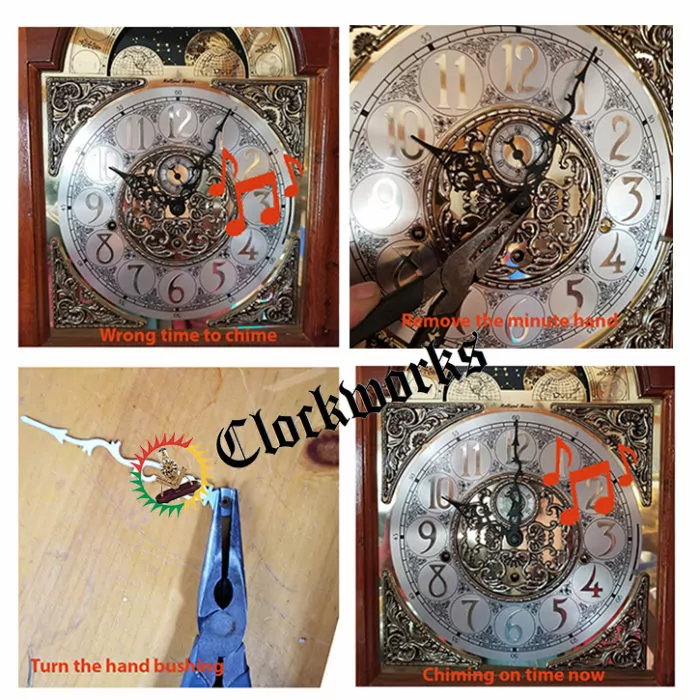
Mechanical clock hand nuts
One of the most common parts a Mechanical clock needs is the hand nut. As we said before, the older the clock the harder things are to find. So, the hand nuts Clockworks offer are for movements made after the 1930's.
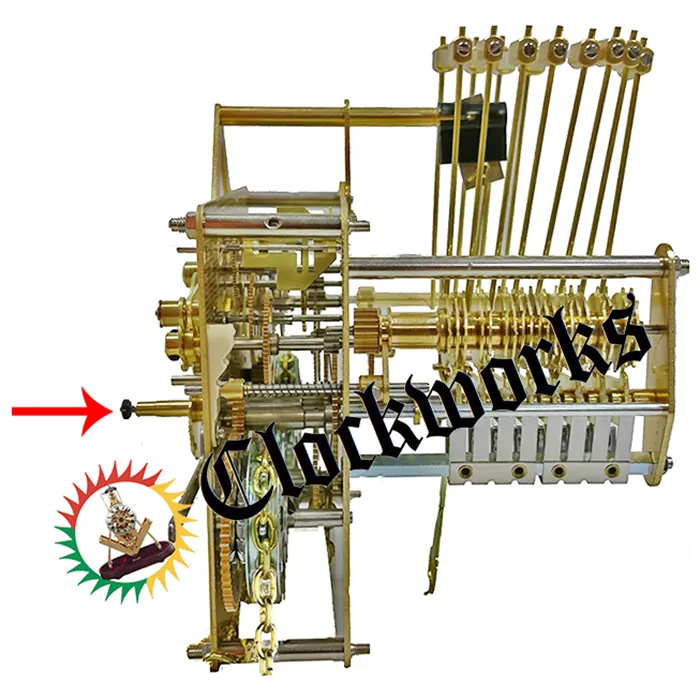
Prior to 1930 clock hand nuts
There were not many standards on what the hand nut size should be on the early clocks. However, prior to around 1930 there is no telling what will work. In other words, it is literally trial and error. There was no standard hand nut size.
Subsequently, any hand nut we offer, may, or may not, work. This includes cuckoo hand nuts, American clock hand nuts, or German hand nuts. However, with even all of these assortments, there is a chance none of them will work on the clock.
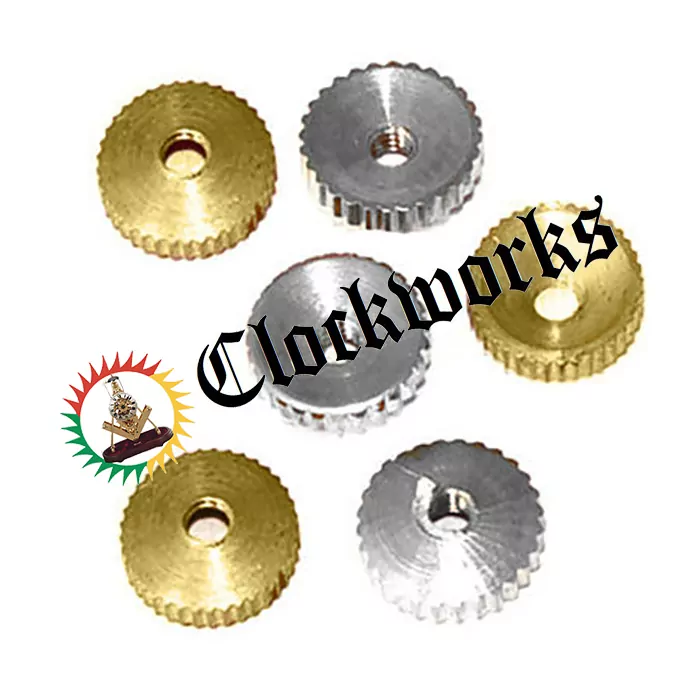
Post 1930 clock hand nuts
Generally speaking, what we have to offer in the three types of clock hand nuts will cover most of the post 1930 Mechanical clocks.
The cuckoo hand nuts fit about 80% of the post war German made cuckoo clocks.
So, the American clock hand nuts fit many of the mechanical time strikes that were so popular. German hand nuts fit most post war German made mechanical clocks, with the exception being a few large grandfather clocks.
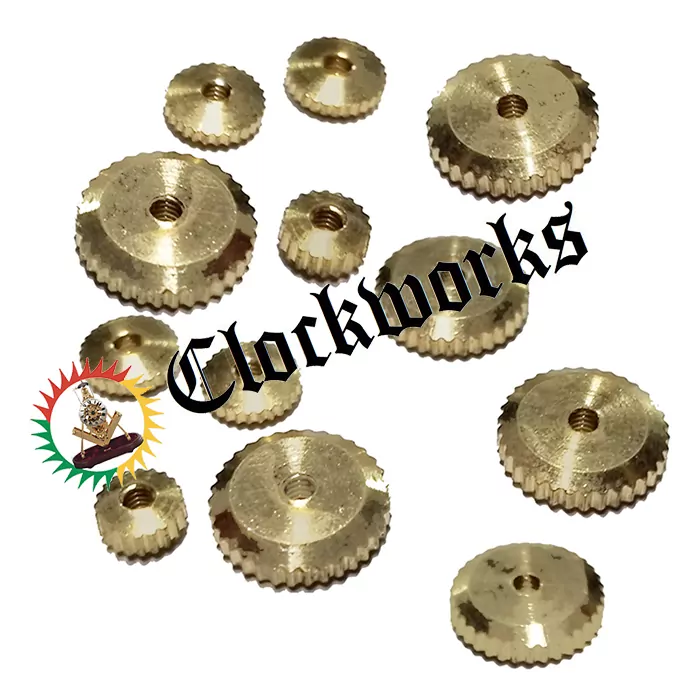
Clocks that do not take a hand nut
However, not all clocks require a hand nut. Some antique mechanical clocks require a clock hand washer and a tapered pin instead. These secure the minute hand as an alternative to the hand nut.
The washer may have a small square hole, or large, oblong or round hole. Clockworks offers an assortment of 100 clock hand washers that includes all the styles above. Use a taper pin to secure the hand with the washer on top of it.
Insert the taper pin into the hole in the end of the minute hand arbor to secure the washer and minute hand to the clock. A taper pin is a small brass or steel rod that is wide on one end and skinny on the other. Clockworks offers them in an assortment of 100 to ensure the right one is there.
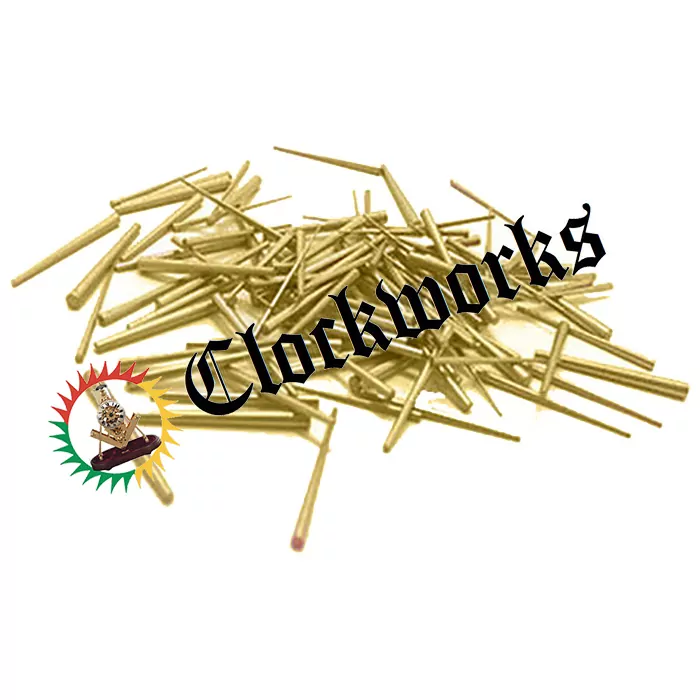
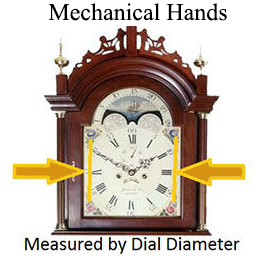
Serpentine Mechanical Clock Hands
This is a set of Serpentine Mechanical Clock Hands that fit most German mechanical clock movements made after 1950. Measure the hands by the time track diameter. A time track is the small ring outside of the numerals and the minute hand length will be about half this diameter.The hour hand is included and of course shorter. The minute hand has a 2.2mm square mounting hole, the hour hand has a 4.5mm round hole. Please note these will not fit the Hermle 1171 series, nor the Kieninger H series.

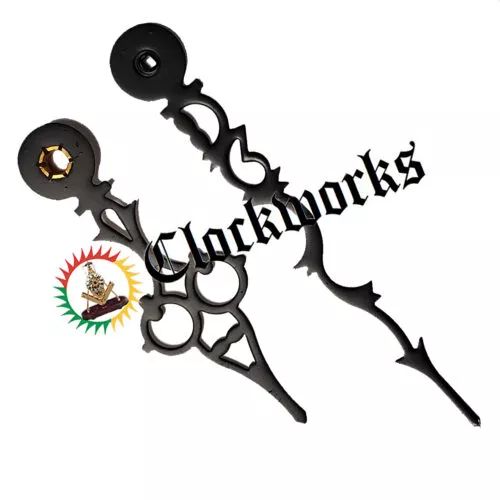
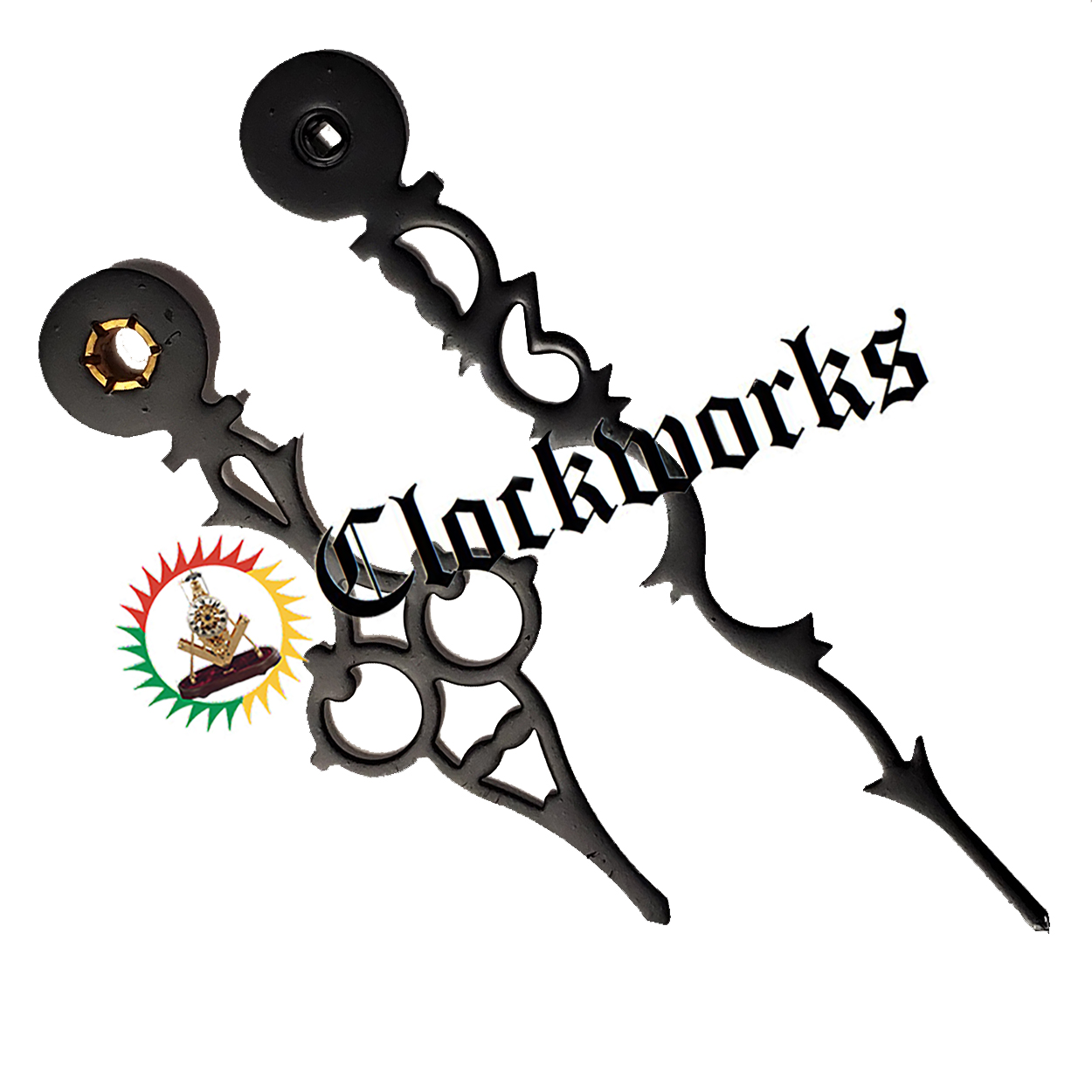
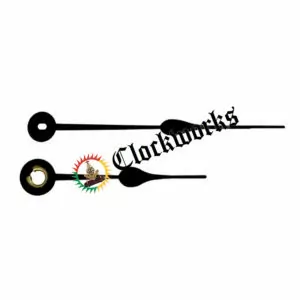
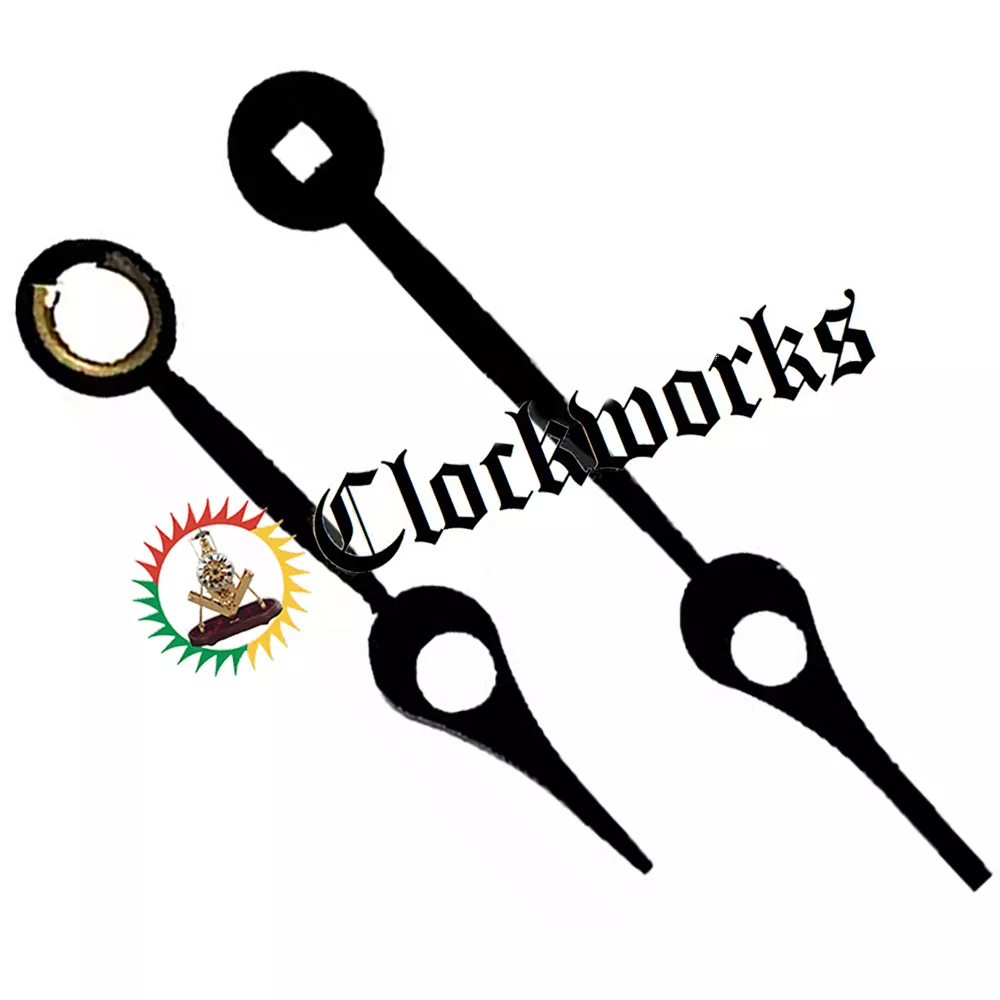
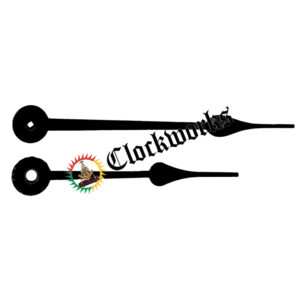











Hello, I have a Ridgeway wall clock -made in Germany, rather large, over 44+ inches long. Has a 6 1/4″ bezel. No model number but the movement has a mark on it that says; UW 6/72 A. Would the part number SKU: CH3Hands fit my clock?
Thanks,
John
Yes they will
James Stoudenmire
30yr Clockmaker
Author of Clockworks.com
Hi James edit and follow-up to my minute hand adjustment question, I reread your instructions again and as you suggested with a little more force I was able to get the hand bushing to rotate, I guess after never been adjusted or modified in the past 35yrs, the clock movement is stamped “A” so 1988, I just purchased, clock has been in a office board room it’s whole life, they had silence the chrimes( too much noise in meetings, etc) the clock works shows little wear, I cleaned and oil all pivots…..running great. Thanks for your website, very helpful. Jeff
Great Job !
|
James Stoudenmire
30yr Clockmaker
Author of Clockworks.com
Hi James, love your website, question on my Craftime with Hermle 1161-853BS works, my minute hand needs to adjusted to chime time, I tried to adjust as per your guide, but will not budge, I have seen other minute hands that have a hex nut on back to assist in this adjustment but mine is just a round bushing. Is this hand adjustable in your opinion? Somewhat afraid to applying too much force and damage hand.. I need to move it approximately 1/4” at the most Thanks in advance Jeff
Force it, make it move, it will move. If you kill it we have them
James Stoudenmire
30yr Clockmaker
Author of Clockworks.com
Would these fit a John Thomas London chiming clock. Numbers n the back are: UW 20/8. Under that is 93627
Yes will fit
James Stoudenmire
30yr Clockmaker
Author of Clockworks.com
Would these hands fit a Howard Miller 612-221movement? They look correct but I don’t have a way to accurately measure the little shaft. I also need a hand nut, would I need a German style nut?
What are the numbers off of the back plate of the clock movement itself? If it is hard to get to, usually you can stick a cell phone up behind the movement and get a picture of the numbers. Or through the side access panel if there is one.
James Stoudenmire
30yr Clockmaker
Author of Clockworks.com
1051-030A
45 cm
102
Those are all the numbers I see on the back plate.
Yes they will fit perfectly
James Stoudenmire
30yr Clockmaker
Author of Clockworks.com
Greetings!
Will your clock hands work on a 1914 Ingraham mantle clock?
Kind regards,
No not these, it would be hands for an American style clock, top row of this link
https://www.clockworks.com/?post_type=product&s=American+hands
James Stoudenmire
30yr Clockmaker
Author of Clockworks.com
I have an Urgos 32008 movement and has a 7.5 inch face. The hour hand shaft is 1.5 mm and the minute shaft is 1 mm square. What hands can I order that will fit this. It is the hour shaft that I am having the most trouble with. Thank You.
Hands for a german mechanical clock
https://www.clockworks.com/?post_type=products&s=german+hands
The hands are measured by the time track diameter (just outside the numerals like outside of the 9 to outside of the 6), the minute hand length will be about half this diameter. Comes also with the shorter hour hand included in the set.
James Stoudenmire
30yr Clockmaker
Author of Clockworks.com
these fit the 141-040 hermele? I just bought for my napoleon wall clock but the old arms don’t fit.
Yes they do
James Stoudenmire
30yr Clockmaker
Author of Clockworks.com
have a friend whos Daneker regency grandfather clock has the minute hand sweeping the dial like a second hand when running, am i wrong in suspecting hands have been changed and wrong ones used? Am unable to find a set of hands so far on internet that contains a long sweeping second hand.
If the minute hand is spinning around the dial like a second hand, the escapement is not engaging with the pallet arbor on the top of it. The movement needs attention and not the hands itself. What is the movement numbers?
James Stoudenmire
30yr Clockmaker
Author of Clockworks.com
I have acquired my first grandfather clock and need to replace the hands. It appears to be a Jauch. The hour hand has 3 square edges on the center hole and slightly rounded on the 4th side. I am not sure about much more. Can you please suggest the hands needed?
Do not have the Jauch hands, that company went out of business around 40 years ago, but if you get a new movement conversion to replace that one, it will come with hands.
Please let me know if your interested
James Stoudenmire
30yr Clockmaker
Author of Clockworks.com
Hi! I have a 2000 Howard Miller grandfather clock. The hour hand does not move when adjusting the minute hand. Could new hands be my fix?
Hi,
Very strange thing to happen,
What are the numbers off of the back plate of the clock movement itself? If it is hard to get to, usually you can stick a cell phone up behind the movement and get a picture of the numbers. Or through the side access panel if there is one.
James Stoudenmire
30yr Clockmaker
Author of Clockworks.com
More details 🙂 the clock keeps perfect time but whatever change I try to make manually with the hands does not register on the clock.
I just dont understand from here. We can offer a new movement if you like however
What are the numbers off of the back plate of the clock movement itself? If it is hard to get to, usually you can stick a cell phone up behind the movement and get a picture of the numbers. Or through the side access panel if there is one.
James Stoudenmire
30yr Clockmaker
Author of Clockworks.com
Hi – I may be responding this twice. Sorry. The numbers are MSU 01. 116 cm 354 394.
Got it
James Stoudenmire
30yr Clockmaker
Author of Clockworks.com
Please order the Kieninger MS series from this link
https://www.clockworks.com/product/new-ms-series-kieninger-clock-movements
James Stoudenmire
30yr Clockmaker
Author of Clockworks.com
Hi – I see MSU01 116cm 354 394. It’s a Howard Miller millennium edition. Keeps perfect time but I can’t get the actual time correct because moving the hands doesn’t seem to register when I move them manually! Thank you
Does not register? Not understanding.
James Stoudenmire
30yr Clockmaker
Author of Clockworks.com
Thank you clockworks.
i have a Hermle 3 chain movement. The numbers on the back are “451-050H, 94cm\66” it also says “made in USA. I need a set of Clock Hands. Looking at the pictures it appears i currently have the German Serpentine Mechanical clock Hands. The clocks is approx. 15 years old. my hour hand spins on the shaft. Will the German Serpinetin hands work for me?
Hi,
If the hour hand is loose on its post it only needs to be pushed back more onto it. The more back, the tighter, and its only a friction fit.
Hands for a german mechanical clock
https://www.clockworks.com/?post_type=products&s=german+hands
The hands are measured by the time track diameter (just outside the numerals like outside of the 9 to outside of the 6), the minute hand length will be about half this diameter. Comes also with the shorter hour hand included in the set.
James Stoudenmire
30yr Clockmaker
Author of Clockworks.com
hi, i just bought the Franz Hermle 141-040K 38cm clock, would like to buy the clock hand, can you please tell me which one is fit for the clock, thanks,
The ones on this very page will be fine. Or the Spade hands for German mechanical units will work also
James Stoudenmire
30yr Clockmaker
Author of Clockworks.com
I need minute and hour hands for an Ansonian time only, 2 weight regulator clock.
The minute hand is held in place by a tiny sharp pin.
The center of the clock face to the numbers measured 3 1/2 inches
I need a set of hand for a W Haid bracket clock with a Hermle 340-020 movement.
Hi,
We have these serpentine hands that will fit up
https://www.clockworks.com/product/serpentine-hands-for-german-mechanical-clocks
Or these spade hands
https://www.clockworks.com/product/mechanical-clock-spade-hands
James
i have a swiss jaeger music box alarm ,face is less then 3 inch acrossdo you have a replacement for the hour hand in gold color ?
Sorry does not seem we have those clock hands
James
Would the serpentine hands fit a German movement made in the inter-war years? How does one order the correct length.? Does the size mean inches of cm?
Please see this link: https://www.clockworks.com/product-category/all-clock-parts/clock-hands
Thank you !
I have tried to move the bushing on my minute hand. (It’s a 21 year old set of hands). I cannot get the bushing to turn and therefore I cannot get the minute hand adjusted to where the clock chimes. Is there anything else I can do? Do I need a new set of hands? I just replaced the mechanical works and I am trying to get the clock time and chimes (Westminster) set.
Make it turn. It turns. If you kill it, we sell them
Thank you !
does the minute hand have the bushing that allows you to adjust its position ?
Yes they sure do !
Mechanical Clock Chime On Time
These are the directions to get a German mechanical clock to chime on time. This means having the clock hands point to the right spot when the clock chimes. When replacing a clock movement , or getting new clock hands , either one, you will notice it will chime 5 minutes before it is supposed to, or 10 min after, something like this. This page explains how to correct this situation. It is unbelievably fast and easy to do.
Working with the minute hand
After a new mechanical movement is installed, or if you are just installing a new set of hands , it maybe noticed the clock will not chime at the time it’s supposed to. To correct this, take the minute hand off of the clock. This is the longer of the two hands.
With this minute hand off of the clock, turn it upside down and look that it has a square hole where it attaches to the clock. This square hole is in a bushing that will rotate WITHIN the minute hand itself.
The correction
So, all to be done is just use needle nose pliers to turn this bushing ever so slightly. Put the hand back on the clock and see if it’s pointing to the correct place where it chimed. If it is, then it all set and it will point to the exact place it is supposed too. If it is still not right, take the hand off and try again. Once you get the minute hand to point where it just chimed you then set to the correct time.
The conclusion
It is really that easy, there is nothing to do with the clock itself, only the minute hand. In other words, to put it in a silly way, take the minute hand off of the clock and walk to the garage with it. Take it far, far away from the clock. When in your garage take needle nose pliers
Thank you !
thank you Sir! I am going to continue on this site and go ahead and or a set of the German Serpinetine Hands. thanks so much!
I received the clock hands. However, is there anything else I need to secure the hands?
The hands for a German mechanical clock such as these would require a hand nut. We have an assortment of mechanical hand nuts for German units at this link https://www.clockworks.com/product/german-hand-nuts It will solve the problem for sure.